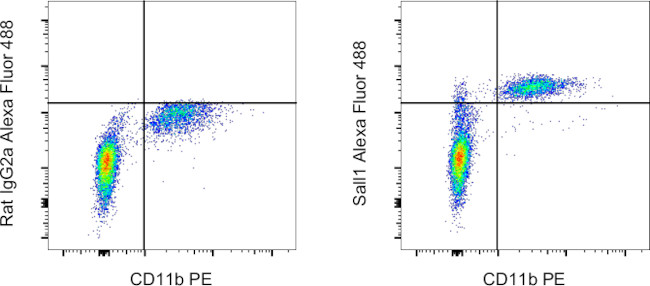Search Thermo Fisher Scientific
Invitrogen
Sall1 Monoclonal Antibody (NRNSTNX), Alexa Fluor™ 488, eBioscience™
This Antibody was verified by Relative expression to ensure that the antibody binds to the antigen stated.
图: 1 / 2
Sall1 Antibody (53-9729-82) in Flow


产品信息
53-9729-82
种属反应
宿主/亚型
分类
类型
克隆号
抗原
偶联物
激发/发射光谱
形式
浓度
纯化类型
保存液
内含物
保存条件
运输条件
RRID
产品详细信息
Description: This NRNSTNX monoclonal antibody recognizes mouse Sall1.
Applications Reported: This NRNSTNX antibody has been reported for use in intracellular staining followed by flow cytometric analysis.
Applications Tested: This NRNSTNX antibody has been tested by intracellular staining followed by flow cytometric analysis of mouse brain cells using the Intracellular Fixation & Permeabilization Buffer Set (Product # 88-8824-00) and protocol. Please refer to "Staining Intracellular Antigens for Flow Cytometry, Protocol A: Two step protocol for intracellular (cytoplasmic) proteins" located at Flow Protocols . This may be used at less than or equal to 1.0 µg per test. A test is defined as the amount (µg) of antibody that will stain a cell sample in a final volume of 100 µL. Cell number should be determined empirically but can range from 10^5 to 10^8 cells/test. It is recommended that the antibody be carefully titrated for optimal performance in the assay of interest.
Excitation: 488 nm; Emission: 519 nm; Laser: Blue Laser.
靶标信息
Sall1, which encodes a zinc finger protein, functions as a transcriptional repressor and interacts physically with histone deacetylase and other components of the chromatin remodeling NuRD complex. It is unknown whether the transcriptional repression is solely dependent on histone deacetylase activity. Gene expression profiling has identified Sall1 as a microglial signature gene. Microglia are the resident macrophages of the central nervous system (CNS). Sall1 is also expressed in abundance in the mesenchyme-derived structure from condensed mesenchyme, S-comma-shaped bodies, to renal tubules and podocytes. Sall1 has been identified as a key transcription factor in self-renewal renal progenitor cells. Sall1 is required to maintain the stemness of nephron progenitor cells by restraining their differentiation into renal vesicles. Defects in SALL1 are the cause of Townes-Brocks syndrome as well as bronchio-oto-renal syndrome. Heterozygous mutations of human SALL1 leading to Townes-Brocks syndrome features dysplastic ears, preaxial polydactyly, imperforate anus, and less commonly, kidney and heart anomalies (Kohlhase et al. 1998). Two transcript variants encoding different isoforms have been found for this gene.
仅用于科研。不用于诊断过程。未经明确授权不得转售。
How to use the Panel Builder
Watch the video to learn how to use the Invitrogen Flow Cytometry Panel Builder to build your next flow cytometry panel in 5 easy steps.
篇参考文献 (0)
生物信息学
蛋白别名: sal-3; sal-like protein 1; zinc finger protein Spalt-3
基因别名: Msal-3
Entrez Gene ID: (Mouse) 58198




